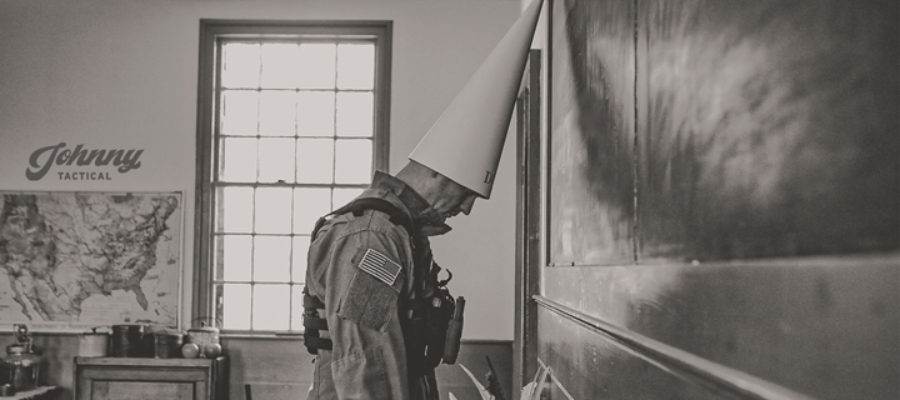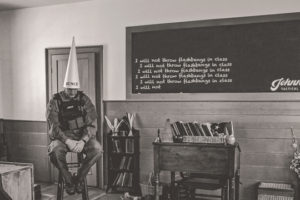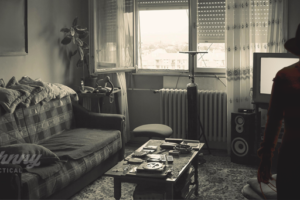Last week we laid out room clearing principles that apply to a wide variety of scenarios. If you haven’t read Part I, go back and read it first.
This week we continue the conversation around room clearing for the tactical dunce. We’re not teaching rocket science or nuclear fission here. This is stuff anyone can learn and do. As a friendly reminder, there are plenty of ways to skin this cat, so don’t get crazy if you have a different opinion here or there. Trust me, I understand that effective and efficient room clearing is a huge topic and this is barely scratching the surface. With that said, we all have to start somewhere.
Now let’s break down some terms and give you a big-picture view of some of the challenges you might encounter clearing rooms and how to deal with them.
PART II: Tactics
1. Doors
There are typically two types of doors; open doors and closed doors. And there are two combinations of those doors; inward opening and outward opening. Why does the direction they open matter? Because that will tell you if the door needs to be rammed or pried open. Inward opening doors need to be rammed while outward opening doors need to be pried. How do you tell? Just look for the hinges. If you can see the hinges then the door is outward opening.
Open Doors
As a matter of order of priority, open doors should be dealt with first. Remember, open doors take priority over closed doors because they pose the greatest threat since they offer a clear line of sight to a waiting enemy.
Closed Doors / Unlocked
If you and your partner are on opposite sides of a door, the knob side person opens the door while the hinge side person is first to enter by beginning with a threshold evaluation.
If you and your partner are on the same side of the door (one person in front of the other) the person in the back reaches forward, around the outside of the person in front, and opens the door. The person in front then begins to clear by using a threshold evaluation and then is first to enter. This is all done with a healthy amount of communication.
Closed Doors / Locked
When possible, leave the locked door for last unless you have some sort of intelligence that informs you otherwise. When you encounter a door that needs to be breached, call up a third person to act as the breacher. Sometimes, space won’t allow for a third person, so you’ll have to use your best judgement on the fly. Your roles won’t change except that one of you will act as cover for the breacher. Once the door is opened, the breacher will get out of the way so you can begin clearing the room from the threshold.
2. Rooms
There are only two types of rooms; corner fed and center fed.
Corner Fed
A corner fed room is a tactical way of saying the doorway is positioned nearest to the corner of the room. You know when you open a door and the door basically hits the inside wall? That’s a corner fed room.
Center Fed
A center fed room is a tactical way of saying the doorway is nearest to the center of the room. You know when you open a door and the door basically opens up into the center of the room? That’s a center fed room.
Not all rooms are shaped like squares or rectangles, of course. Some are asymmetrical, L-shaped, have cubbies, closets, and crawl spaces. Deep corners or “L’s” are dealt with like an open door. Just slice that pie like you normally would. Closets, cubbies, and crawl spaces are no different than opening and clearing any other door. Don’t let them freak you out.
3. Entering Rooms
There are only two ways to enter a room; criss-cross or button hook. Whichever you choose, I recommend the first man in should take the path of least resistance. That just means you should move into the room in the direction you are already facing. If my feet and my body are pointed in one direction, and I move in another, it takes more footwork and more time to get my butt in there efficiently.
Whoever sliced the pie has seen 80-90% of the room and will typically be the first to enter. It doesn’t matter who goes first, it just matters that you communicate it and are both on the same page. If communication doesn’t happen verbally, then there ought to be a squeeze of the thigh or shoulder, a nod of the head, or dip of the muzzle. Worst case scenario is the second man needs to read the first man’s movement and play off of it. If the first man goes left, the second man must go right. The first man can be less right but is never wrong.
4. Hallways
Think of hallways like long, skinny rooms that sometimes have lots of connecting rooms. I’ve seen people lose their minds when dealing with a hallway in a school or office building because they over-complicated it and let themselves get overwhelmed. Don’t over-complicate a hallway. Treat a hallway like a room, doors like doors, and intersections like open doors. As long as you cover the angles, you will be fine.
In an average hallway the things that screw people up the most are four-way intersections, L-shaped intersections, T-shaped intersections, and opposing doors. It can feel like input overload, but it doesn’t have to be that way. Sure, two or three angles may need to be covered simultaneously, but as long as you are aware of your angles and your position in relation to those angles, you will be fine. This is where manpower comes in.
Let’s break it down:
5. Opposing Doors
Opposing doors are simply doors facing each other on opposite sides of a hallway. You deal with them by having one guy cover one door while another set of guys slice the pie and then clear the opposing room. Once one room is done, switch sides. Begin clearing the room that is deemed to be the greatest threat first. All things being equal, it doesn’t matter which one you start with.
Keep in mind that the point man (the guy in front) needs to maintain long cover (everything in front of you down the hall) while the side rooms are being cleared and/or covered. Do this one at time, over and over, until you get to the end. If you have enough people to help out and adequate space in the hallway, you could handle opposing doors simultaneously.
6. Four-way Intersections
A four-way intersection is no different than a hallway with opposing open doors. Treat them as such.
7. L-shaped and T-shaped Intersections
Treat L-shaped intersections like an open door and T-shaped intersections like opposing open doors.
8. Eliminate Variables
The key to clearing hallways and rooms safely is to eliminate variables. The more variables you eliminate, the easier the problem is to solve and the simpler it becomes. For example, if I encounter opposing open doors in a hallway, that’s two variables. If I cover one doorway, I just eliminated one variable. Now I just need to worry about clearing one room. When that room is clear, I then clear the other, and so on.
9. Watch the Angles
Clearing rooms and hallways is a game of angles and a game of inches. Being aware that angles run infinitely in any direction will pay dividends. Sometimes we only think about what is right in front of us, not 100 yards down a hallway or through a bunch of connecting open doors three rooms away that expose us.
10. Tools to Consider
Just because we can understand how to clear a room and practice doing it, that does not eliminate danger. It only mitigates it. There is always risk involved. There are additional steps we can take that can further mitigate risk and those generally involve tools of various forms like hand-held mirrors, police dogs, pole cameras, robots, and drones. The more tools you can utilize before putting yourself or someone else in a room, the safer you will be. Don’t go for sexy, go for safe. Keep in mind that no single tool is ever 100%.
Final Thoughts
Reading about it all in a blog can be confusing, so don’t feel bad if these ideas got twisted up in your mind while reading it. God willing we’ll be releasing illustrated and/or video lessons in the near future, so stay tuned.
In the meantime, if you encounter buildings and rooms that need to be cleared, just remember this if nothing else:
- Slow down.
- Think.
- Simplify.
- Eliminate variables.
- Communicate.
__________________________
Thanks for reading! Do you have a story that you think we could learn from and that you’d like to share with Johnny Tactical nation? Fill out the contact form and include your name, rank, and department, or email it to [email protected] and follow these guidelines:
- It must be a firsthand account
- True
- Have a lesson, principle, or tactic to apply
- Cleaned of names, dates, and places
- Include your call sign
If your story is selected and published in our blog you’ll get the credit using your call sign and we’ll send you a free Johnny Tactical morale patch.






Leave a Reply
Your email is safe with us.
You must be logged in to post a comment.